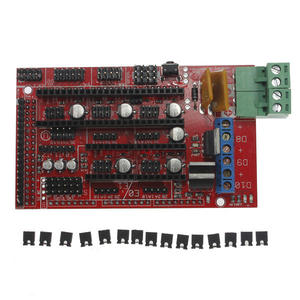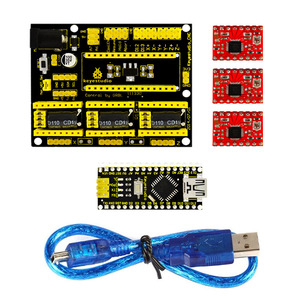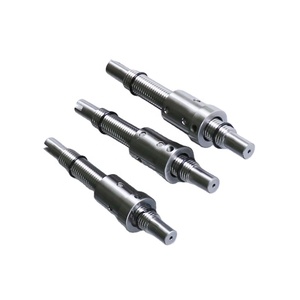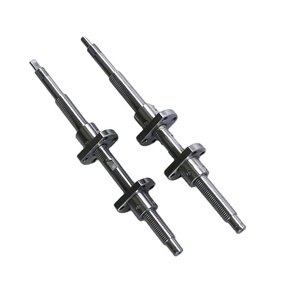(526 products available)















































































































































































































Market Overview: The Arduino CNC market is part of the broader Computerized Numerical Control (CNC) sector, which has shown remarkable growth in recent years. According to 360iResearch™, the global CNC market grew from USD 65.78 billion in 2023 to USD 73.33 billion in 2024, with an impressive forecasted CAGR of 12.93%, expected to reach USD 154.09 billion by 2030. This growth is fueled by increasing automation demands, particularly in industries like electronics and manufacturing, where Arduino CNC systems provide a cost-effective solution for precision control and prototyping. The integration of advanced technologies such as IoT and AI further enhances the capabilities of Arduino CNC setups, making them appealing for both hobbyists and small to medium enterprises looking to streamline operations.
Industry Insights: The rising popularity of Arduino CNC systems reflects a shift in consumer behavior towards accessible and customizable manufacturing solutions. As noted in recent reports, the CNC machines market is expanding due to advancements in technology and a growing emphasis on high-precision components. The adoption of Arduino CNC solutions is particularly significant in regions like Asia-Pacific, where manufacturing investments are surging, and demand for innovative machining technologies is on the rise. Additionally, challenges such as high initial costs and the need for skilled operators remain, yet the ongoing trend towards energy-efficient and smart manufacturing solutions presents lucrative opportunities for growth. Companies involved in this sector are continuously exploring ways to improve user interfaces and reduce operational complexities, positioning themselves favorably in the competitive landscape.
An Arduino CNC has many variations, each serving different needs. Below are some of the most common types of Arduino CNC machines:
CNC Laser Cutters
CNC machines using lasers are referred to as Arduino CNC laser cutters. They make use of high-precision laser beams to cut various types of materials such as acrylic, wood, metal, etc. If an easy engraving project is what is desired, then a laser-cut CNC machine would be the best choice. This machine is also easy to assemble and can be built via an Arduino or a laser module.
CNC Milling Machines
An Arduino CNC milling machine is a computer-controlled device that can precisely remove material from a workpiece to create a desired shape or design. This is done by adding a third component - the spindle that rotates as the tool moves in three directions. The advantage of CNC milling machines is their high accuracy and ability to create complex shapes.
CNC Wood Routers
These machines are similar to CNC milling machines but are specifically designed for woodworking tasks. They utilize the Arduino board for control and routing to carve, cut, and engrave wood projects with precision. Also, wood routers offer a large cutting area and enable the CNC to work on materials like foam and PVC.
CNC Pen Plotters
An Arduino CNC pen plotter is a drawing machine that uses an Arduino microcontroller to control the movement of a pen. The pen is mounted on the plotter and is moved in two directions (usually horizontally and vertically) to create drawings, graphs, and designs on paper. This type of CNC machine is relatively easy to construct.
CNC Milling Machines
These machines are similar to CNC milling machines but are specifically designed for woodworking tasks. They utilize the Arduino board for control and routing to carve, cut, and engrave wood projects with precision. Also, wood routers offer a large cutting area and enable the CNC to work on materials like foam and PVC.
Low-cost CNC machines with versatile designs mainly suit the following scenario applications of Arduino CNCs.
Creative Projects and Prototyping
Arduino CNC is utilized frequently in workshops, makerspaces, and educational institutions for creative projects and prototyping. In the field of architecture and design, they can be used to prototype products, create architectural models, design prototypes, and more. In the fields of art and crafts, they can be used to make custom jewelry boxes, painted signs, home decor, and more; in software development, they can be used to create software user interfaces, hardware devices, and more; and in the field of entrepreneurship and startups, they can be used to make minimal viable products, showcase products, and more.
Light Industrial and Small-Batch Production
Arduino CNC can be used for light industrial and small-batch production in the fields of clothing and textile manufacturing, woodworking, electronics, and light metal processing. They are suitable for producing non-massively manufactured goods that require a modest level of automation, as well as for making prototyping and testing small quantities of products.
Home and DIY Projects
Arduino CNC also applies to many Arduino DIY and home projects. It is a handy tool for home improvement enthusiasts and DIY aficionados to realize their creative ideas. Whether building custom furniture, making home decor, personalized gifts, or performing renovation projects, these CNC machines can offer precisely as needed.
Hobbies
Often, an Arduino CNC kit is employed to satisfy one's personal interests in a variety of hobbies. Its applications span a wide range of endeavors, from model making and crafting to jewelry design, clockmaking, and even race car assembly, as well as creating musical instruments and customizing existing ones.
Education
Arduino CNC plays an essential role in educational settings. It is commonly used to teach students about engineering, computer programming, and design. Additionally, these CNC kits enable hands-on learning experiences wherein students can develop their creativity and problem-solving abilities. More importantly, they can gain practical skills by operating the machine and working on projects.
When choosing Arduino CNC projects, the following factors should be considered:
Q1: What materials can an Arduino CNC project work with?
A1: It depends on the type of CNC project. Generally, CNCs can work with a variety of materials like wood, plastics, metals, foam, and more. Nonetheless, an Arduino CNC would be better suited for softer materials considering its motor power and control.
Q2: What size can an Arduino CNC project accommodate?
A2: The size of an Arduino CNC project is mainly determined by its frame and motor capabilities. Most small-scale CNCs can manage work areas of about 200mm x 200mm up to 500mm x 500mm. For larger projects, one may need multiple Arduino boards to handle the space and tasks.
Q3: How precise are Arduino CNC projects?
A3: CNCs are generally very accurate, high-performance machines. While a hobbyist Arduino CNC may not achieve industrial-level precision, it can be quite accurate when well built and calibrated. Most hobbyist CNCs achieve an accuracy of about 0.1mm to 0.01mm.
Q4: What type of bits works best with an Arduino CNC project?
A4: Once again, this largely depends on the material being worked on. Nonetheless, the most common types are composite bits for plastics and wood; carbide-tipped bits for tougher materials like MDF; and fluted end mills for metals. Whichever the case, it is best to use bits that are specifically designed for CNC use.
Q5: Does an Arduino CNC project require professional assembly?
A5: One does not need to be a professional in order to assemble an Arduino CNC project. Provided they possess the necessary skills, they're able to assemble the machine. Nonetheless, the project may require machining expertise, electronic skills, and programming knowledge. However, with the availability of online tutorials and community support, many first-timers have successfully assembled their CNC projects.